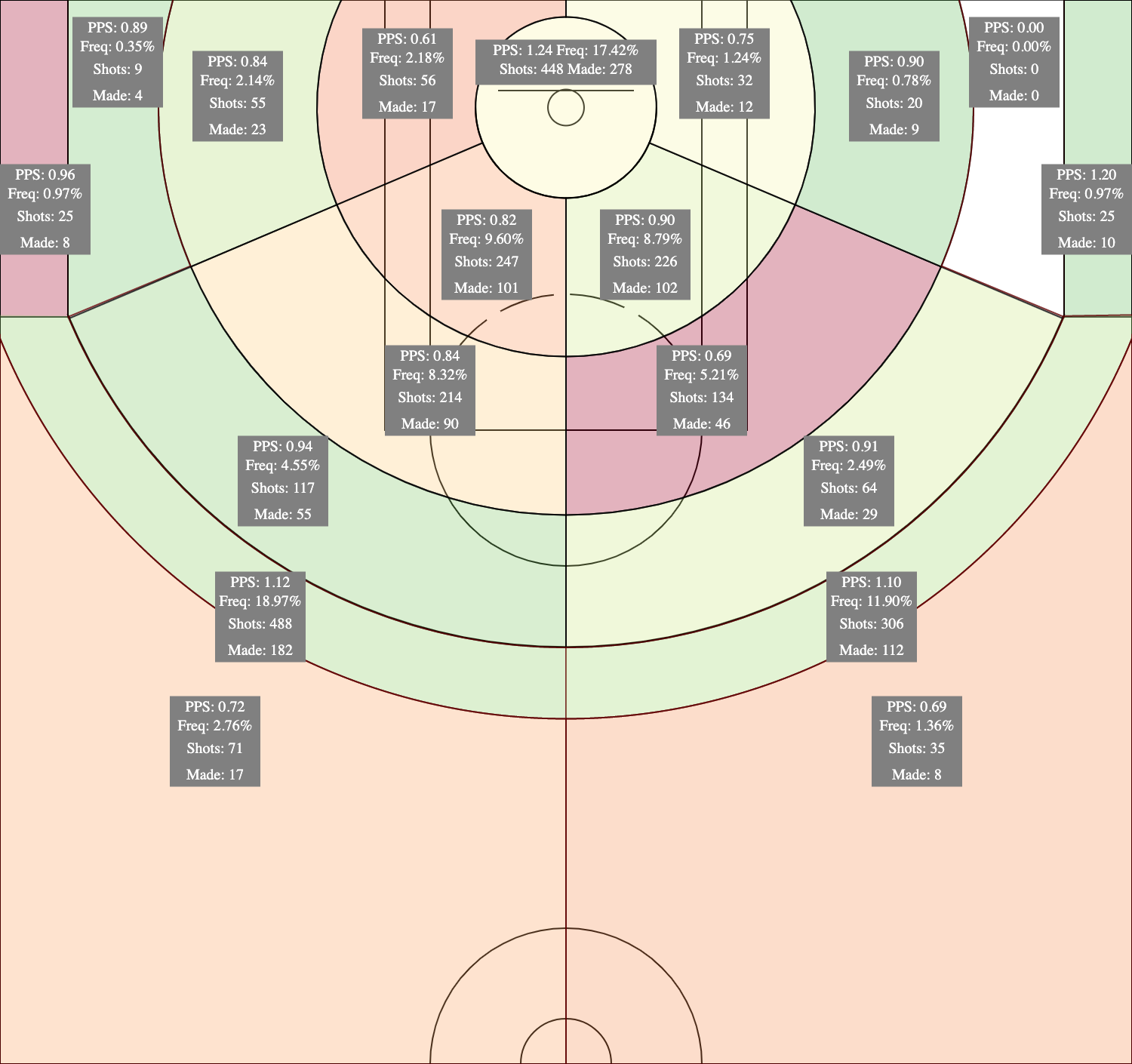*(Offensive Rebounds)
Where the newest Laker fits into the team’s offense, defense, rotation, and the team’s playoff run.
Reinforcements are on the way! The Lakers have made a move to sign Andre Drummond with one of their two (current) open roster spots, bringing additional short-term hope to what’s been rough outing after rough outing, even during wins, since LeBron went down to injury.
Over the past week and past 3 Lakers Exceptionalism Podcasts, I’ve shared some data points, analysis, questions, and hopefully some answers. I want to synthesize much of that here, since 5 positive looking tweets in a row on one night or 10 negative ones on another night leave more room for assumption into my actual analysis than I’d prefer.
Let’s cover, area by area, what Andre Drummond does bring and does not bring to the Lakers. We’ll debunk some myths, confirm some narratives, do some Xs & Os brainstorming for his fit, forecast some lineups and rotations, and leave you with a more clear picture of what to expect from Dre over the coming days, weeks, and months.
Expect his role to change over time?
Not just because he’s being integrated as a new piece and the Lakers may still be learning about how to best fit him into the team’s rotation, but because his environment will shift substantially between starting his Lakers career with neither of LeBron/AD playing, then just with AD playing, then with both playing.
To start, he’s stepping into a hobbled Lakers rotation missing its best two players. This, along with Drummond being in his initial transition phase, presents the most obvious situation for Dre to be Dre with how he’s used offensively.
But I’d love to see the Lakers look bigger picture, realize that Dre hasn’t played a game since February 12th, just 2 days before Anthony Davis went out with injury, and find a smarter short and long-term way to integrate him with the skill sets on the roster healthy right now.
That’d mean him fighting on the glass on both ends, but offensively spending a lot of time in the high post area as a facilitator helping get THT, Schröder, and other players attacking the rim downhill. Feeding him in the post a bunch isn’t a great short-term strategy and has no real carryover to the long-term with LA either.
Quickly back to Dre’s time off. Drummond hasn’t been injured, but he’s also been in basketball purgatory of not having the same clear objective or potential purpose behind his practice for much of that month and a half. Earlier in the year we saw that Wes and Kieff were cut from the rotation. They stayed ready and had an impact when needed and are part of the rotation now. We’ll need to hope Dre stayed ready and will impress as he steps in to play for the Lakers.
And as he enters a new environment, we’ll need to see if he buys into his roles on both offense and defense.
What has his offensive usage been so far?
Well, it’s been fairly consistent. He’s a Post Scorer, according to the Offensive Archetypes we use at BBall Index. He’s an on-ball scorer and playmaker. This is the same role this season as Anthony Davis.
He’s not an off-ball Stretch Big like Marc Gasol. Nor is he an off-ball Roll & Cut Big like Damian Jones, JaVale McGee, or Dwight Howard.
Drummond is used to the ball in his hands. In fact, his Hog Rate, which is the percentage of time his team’s time of possession when he’s on the court that he individually commands, is a whopping 16.9%. That’s very high ball dominance for a big man, ranking only below Jokic, Embiid, and Adebayo this season among Centers. That’s far higher than Jones or Gasol, higher than AD, KAT, and Vucevic, and nearly DOUBLE Trezz’s rate this season.
For a team missing 2 key on-ball scorers and playmakers, this fills a void. Once the team gets AD, and then LeBron, back, it presents a situation where someone will need to be dropping substantially. Given the relative importance of each player to the Lakers, that likely means Drummond reversing his career climb and bumping himself back to where he used to be 3-4 seasons ago.
We see Montrezl Harrell’s very similar Hog Rates to Dre’s over their careers on this graph. Trezz took his ball dominance dive once joining LA. On a healthy Lakers team I expect the same for Dre.
What I’m most excited for is his Playmaking
Watching Dre’s passing reminds me of Marc Gasol. Or at least pre-Lakers Marc Gasol. They both have the ability and usage as passers from the low post, high post, and top of the key.
They both throw some wicked outlet passes. Dre at a pretty high rate. That’ll be nice to add and help LA get out in transition more often.
As we talked about on the most recent @LakersExPod, expect a lot of rebounds to outlet passes from Drummond.
That + his turnover generation helps lead to a faster pace for his offenses, which should help LA get more frequent easy buckets in transition if they sign him. pic.twitter.com/uOMl48UXSC
— Cranjis McBasketball (@Tim_NBA) March 27, 2021
On film I see Dre’s top of the key passing, which we’d see in “delay” sets where the team goes 5-out with offensive players at the wings and corners to the left and right of Dre. He’ll pass to back cuts, hit the pin down and flare screens well, and execute dribble handoffs. Same as Gasol. The big difference is Dre doesn’t have any 3PT shooting gravity, which results in his man often being sagged a bit into the paint and able to take away cutters.
He'll be similar to Gasol (just lower efficiency) with these types of passes pic.twitter.com/uNLxe7WMdz
— Cranjis McBasketball (@Tim_NBA) March 25, 2021
That, and a tad less needle threading ability, results in Drummond’s rating in our Passing Efficiency metric to be in the 6th percentile on average over the past 3 seasons, as he’s scaled up his Passing Creation Quality and made more ambitious passes. He can do this, and I expect LA to utilize him in this way neatly into the existing sets LA uses with Gasol. Though it isn’t my favorite way to deploy him, based on the spacing concern & slightly duller needle he threads.
As a low post passer, there’s creation there for others but the ratios aren’t where you’d like them to be. Dre is a black hole in the post, not often passing out and even less frequently passing out to an advantage. Because he posts up so much, we still end up seeing his post passing result in assists and some highlights for teammates.
And this isn’t a new issue for Drummond or one that is explained by his team being bad. His post pass out rate this season is 3rd lowest in the NBA (Trezz is 2nd lowest). In Detroit’s playoff year in 2018-19, his 5% pass out rate was dead last. In 2015-16, another playoff year, he was 2nd lowest among players with 20+ chances.
Because I don’t want to sign up for 9 Drummond post scoring attempts for every helpful pass out, given his current and career post scoring inefficiency, this is an area LA is best off cutting from his game if possible.
What this leaves us is an area he’s well equipped to succeed in- the high post. LA’s 1-4 high and horns alignment sets, which each position LA’s PF and C at the elbows, are the perfect places to slot Dre into LA’s existing offense to help him facilitate offense through passing, screening, handoffs, and maybe with a shot if left open. He’s shot 34% from midrange over the past 4 seasons, which is not good at all. It’ll be important to have handoff options to go to if he gets sagged off of.
Imagine a dozen plays like this a game, where Dre gets a high post feed, a Laker player cuts off of him to the rim, then we’ll add on a pin down or flare screen weak side that can flow into a dribble handoff if not open that Dre can roll after as THT or Schröder attacks downhill. If opponents are switching those off-ball actions, Dre’s positioning closer to the rim than the 3-point line and his positioning relative to those actions would put him in a great spot to pass to slipping screeners after a switch. Easy, simple offense that gets attacking towards the rim and for open 3s.
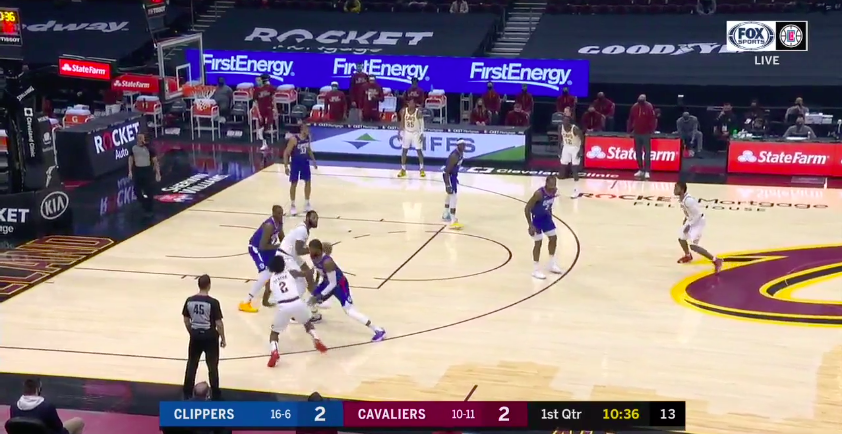
LA had been moving to these kinds of sets more and more right before LeBron went down to injury, finally answering the season-long prayers of my podcast. These were the sets LA was able to get THT & Schröder attacking downhill from. The ones Kuz was able to set a screen himself then sprint into a screen from a teammate for an open 3-point look. The sets that had no bigs lingering in the dunker spot or in the post, which instead opened up driving, cutting, and rolling lanes. Plug him into these and you get the best of Dre’s passing without signing onto high volume low efficiency scoring from him as a post player.
Drummond’s impact as a scorer
As the data I shared on Twitter showed, Dre’s past scoring impact leaves a good bit to be desired. He’s been a high volume post up, putback, and dump off player, often in that order. His efficiency in those areas has generally left much to be desired.
Whether on or off-ball, he’s underwhelmed as a scorer compared to league average efficiency in a number of areas. High volume post scoring on poor efficiency is what gets him F after F grade in his stabilized Post Up Scoring impact. The same can be said for his dump off/cutting game.
Where Drummond scores most often is with his face up post game, his post hook shot, with putbacks, and finishing dump offs.
Here’s his 4-year shot chart from NBAShotCharts. The scale goes from green (good) to red (bad).
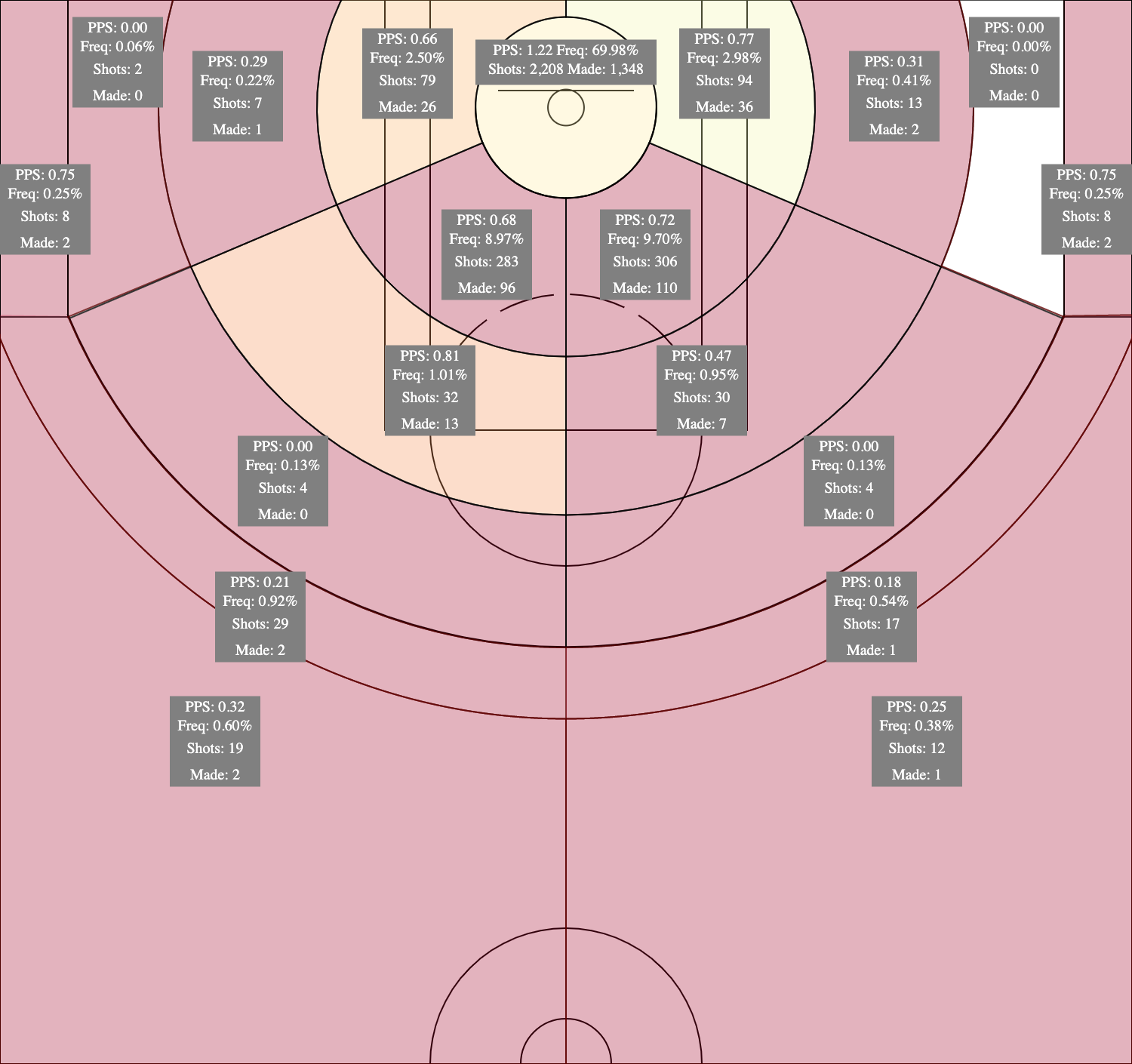
Here’s Marc Gasol’s shot chart for some context.
This isn’t a Dwight situation
It’s truly just not. Dwight was a good player in the wrong role, and it was blatant when looking at his film and data. He was a high volume post player that was not so good at that, but was awesome as a dump off finisher, cutter, roll man, and putback man. That context and skill-driven approach led me to being a proponent of the Lakers signing Dwight Howard in 2019.
If we ignore all that context with Dwight and just look at his efficiency overall, impact overall, or shooting by distance, there’s no way we would’ve arrived at the same conclusion with him back then.
If we take a no context approach with Drummond, we fall into that same trap and ignore the information available to us that signals strongly that Drummond isn’t a victim of poor role-skill fit.
Changed to be a Roll & Cut Big he WILL be more efficient than he is now. But his skill set is less of a match with a Roll & Cut Big role the way Dwight’s was, so this isn’t a situation like that.
Dre isn’t a lob threat
Sure, he can finish a lob. I’ve seen it on film sparingly this year. So can Gasol and Trezz with runways. But the title of “lob threat” is one you use for guys who can rise above and/or catch and finish lobs jumping while stationary with some dgree of consistency, in ways that punish their defender leaving them alone next to the rim, in ways JaVale McGee and Dwight Howard did last season.
I do not expect to see 6 lobs and 10 total dunks in 8 games for Andre Drummond the way we just saw with Damian Jones. That was a lob threat. Dre is a different type of player with his own virtues.
On film, we see the difference between Drummond now, after 4 calf or achilles injuries over his past 13 months of playing and just doesn’t look like the same guy in the data over the past 4 years, and Drummond in earlier years. It shows up from a lob standpoint, in his finishing data, and with his rim protection data.
Is he the next JaVale/Dwight as a dump off guy?
I’ve heard this a lot over recent days. The answer is: he doesn’t profile like one, and there are better options available if you’re looking for one.
If you wanted that guy, there’s no reason Drummond should have been at the top of a wish list. He’s a different kind of player, and one whose best offensive skill set, his playmaking, becomes marginalized if you shift him to this Roll & Cut Big man role he’s never done before.
He’s also just not been good when needing to do what players in that role need to do to succeed. We covered a lot of buyout options on a recent Lakers Exceptionalism Pod. Drummond’s rating in our BBall Index Finishing at Rim metric, which looks at his scoring at the rim while adjusting for his shot quality, was the lowest of any player we covered.
On average over the past four seasons, his average difficulty-adjusted Finishing at Rim rating is higher than only 6% of NBA players. For this season, it’s been higher than only DeMarcus Cousins and Aron Baynes. Below I cover how a role shift and easier shots can increase his efficiency. When it comes down to it, his own degree of underperformance as a finisher limits how well he fits into that type of role.
Can’t the Lakers get Dre easier shots at the rim?
Yes. Or at least vs what he’s gotten this season. His Shot Quality on shots at the rim has been higher than 89% of NBA players on average over the past 4 seasons. That’s very high already. It’s trended down over that span from the 98th percentile to the 94th, 92nd, and now 70th percentile.
That’s a bit below where Montrezl Harrell’s shot quality has been this season (92%) though right about on par if you take his 4-year average. Trezz is another Post Scorer that does a bit of roll & dump off work as well. Only Trezz has constantly overperformed his shot quality, and Dre has constantly underperformed his.
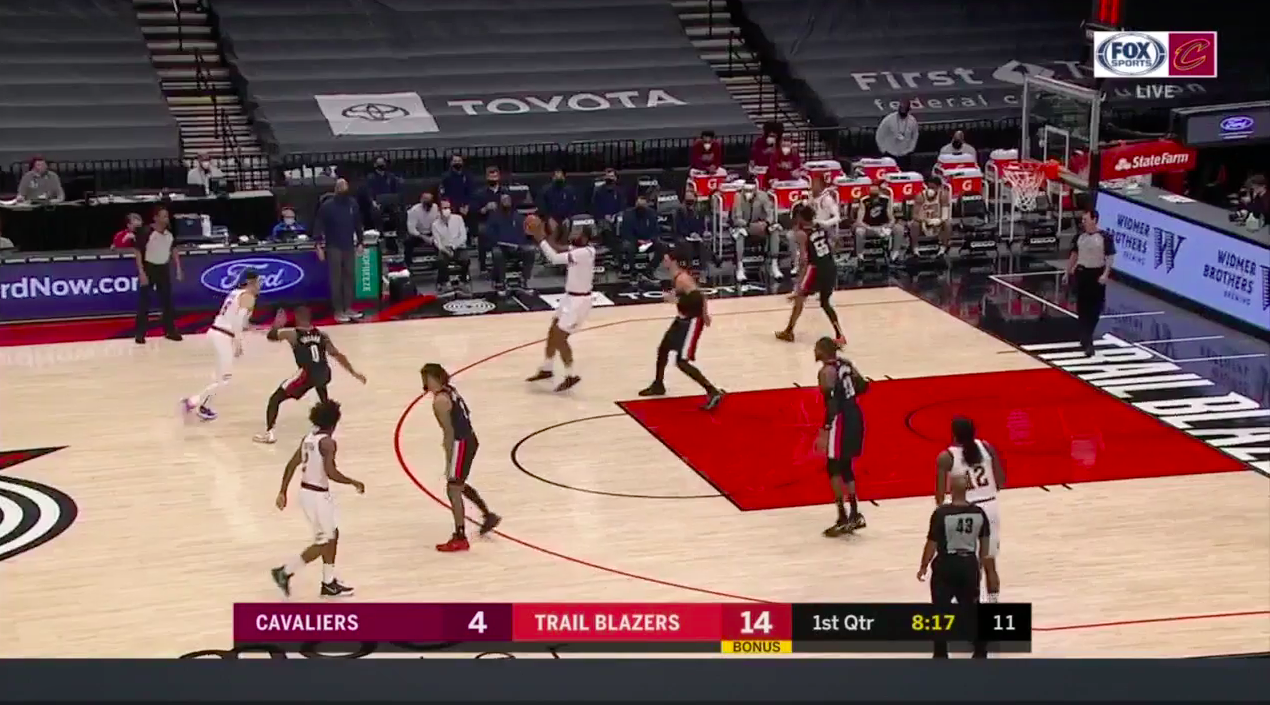
His 4-year Shot Quality at the rim has actually been higher than every player that’s worn a Lakers uniform this season other than Anthony Davis. His current year shot quality is about where Gasol’s is this year and would rank 5th on LA.
Should we expect that 70th percentile to jump substantially? Eh. Not without AD or LeBron. Once both are back, it might. But as long as Dre is posting up, I wouldn’t expect a huge jump.
A lot of other players would, even including other buyout big man options. But Drummond’s shot quality at the rim hasn’t been in the dumps like some would lead you to believe.
So insert him into LA’s team. Does his quality go up? When we look at the Shot Quality at Rim data for players new to the Lakers this season compared to last year, we haven’t seen jumps in shot quality from any of them:
Trezz: 92nd percentile -> 92nd percentile
Gasol: 92nd percentile -> 69th percentile
Schröder: 58th percentile -> 40th percentile
Matthews: 85th percentile -> 66th percentile
If we do assume he jumps from his current 70th percentile Rim Shot Quality up to Trezz’s 92nd percentile. What does that mean for his FG%? It’d be worth about 2.3%, based on our math.
If we apply that to Drummond’s shots around the rim that aren’t post ups (because I don’t see them being impacted), that translates to 5 extra made shots for him this season (10 extra points). An extra 0.4 points per game.
Ideally this also means a higher volume of good shots as well, rather than the same volume but just better shots. If we apply that 2.3% to all shots for Dre at the rim, including his post shots (assuming they ALL turn into set up shots instead). This would be a pretty aggressive shift and be what we’d attribute to his role completely changing to a Roll & Cut Big, since we’re assuming here that he cuts post up shots completely and retains his same high usage, just with it all being translated to off-ball scoring. With all of that, we’re up to 19 extra total points. An extra 0.76 points per game.
The Lakers will get Drummond better shots. It just might equate to an extra half point per game. Drummond himself actually finishing better at the rim, on the quality he’s getting (whatever it looks like), will be the largest area for upside. If his difficulty-adjusted Finishing at Rim jumps up from the current pitiful 3rd worst in the NBA, or from his 4-year average 6th percentile, up to average, and THEN you add in higher shot quality, he’ll start performing the way people are hoping he will.
But if you look at his finishing numbers as being fully due to his shot difficulty because of a crappy situation and attribute none of that underperformance to him, you’re likely in for a surprise.
How about his lineup context?
It hasn’t been great! Though it’s legitimately been good in a few areas and average in a few others.
Here’s the full set of contextual data for the average Lakers rotation player compared with Drummond. All data with garbage time removed. You can see the free, garbage time included version of this data on the site here.
Playmaking: LA 50th percentile, Drummond 90th percentile. Garland and Sexton are a big piece of this, but if you only watch the Lakers and haven’t kept up with their growth as a backcourt it’s understandable that one might dismiss them.
Spacing: LA 36%, Drummond 25%. The spacing around him hasn’t been good, though it’s also been below average for the Lakers.
Scoring Gravity: LA 35%, Drummond 52%
Finishing: LA 45%, Drummond 6%. This’ll be a big step up for Dre, though as a Post Scorer this matters less for him.
Penetrating: LA 51%, Drummond 41%
Drummond will see far worse playmaking on average (though some higher end individual passing from LeBron), slightly better spacing, worse scoring gravity of the players around him, much better finishing, and slightly better penetration.
I also want to note that no, the Cavs have not played a single second this season with Nance, McGee, Drummond, and Allen on the court at the same time. Someone on Twitter mentioned this recently, but that hyperbolic misinformation doesn’t match reality. The only version with 2 of those guys plus Drummond was with McGee and Nance, which made up only 16 of Drummond’s 722 minutes on the season so far. The data we have on his context doesn’t show a man in a wasteland waiting to be saved. It also doesn’t show LA as some perfect environment.
How important is his Defensive Rebounding?
This is an area where the counting stats diverge a bit from the impact he has as a rebounder. You might be familiar with the 9.1 defensive rebounds he’s pulled down per game in his career. That’s an impressive number, but we can dive deeper to learn more.
Looking at his advanced data from this season, or each of the 4 seasons prior, we get a more clear picture on his rebounding.
Dre stands very close to the rim, which helps his opportunities. 92nd percentile positioning means he’s planted next to the rim at very high rates, helping feed his also 92nd percentile defensive rebounding chance rate.
He’s not grabbing contested rebounds. On average, over the past 5 seasons, the percentage of his defensive rebounds that have been contested has been higher than only 39% of Anchor Bigs with 1,000 minutes played in a season.
Dre is also not boxing out much at all. 14th percentile vs that Anchor Big comparison group means few other players in his position are boxing out less. That type of hustle matters when it comes to impacting the team’s ability to rebound.
Because of all of this, even though his volume is elite and his conversion rate individually is elite, enough of his Defensive Rebounding is empty calories and he boxes out so little that his impact on his team’s ability to defensive rebound is higher than only 42% of Anchor Bigs in that comparison group, using NBAShotChart’s Real Adjusted DReb Rate.
But even though he’s a bit oversold as a rebounder, he’s entering a situation where he’s still a step up from the incumbent situation. Looking at that same rebounding impact stat and comparing to all players, we see that Dre’s defensive rebounding far surpasses what Trezz and Gasol have been doing the past 2 seasons. He’s a step below AD, but in this area the Lakers should still reap the benefit of Dre’s rebounding.
Exactly how much that’s the case will depend on the rotation playing time. Or if the Lakers can help tweak his long-standing behavior of not boxing out, we might also see this be even better.
On the season, LA’s DReb% is 7th best in the NBA. Since AD went down, it’s been 9th. Since LeBron went down, it’s gone up to 5th. When LA didn’t have Gasol, LeBron, or AD playing and had McKinnie/Cacok/Kostas minutes, the team wasn’t doing so hot. But those situations shouldn’t happen outside of garbage time now that Gasol is back from his COVID related absence. This adds an additional layer of protection, as does AD coming back relatively soon.
Defensive rebounding is nowhere close to a glaring key issue that the Lakers need to address, but if you can do better than you are today that’ll still be helpful and aid in winning games.
Dre’s Offensive Rebounding
On the defensive boards, Dre has good individual rebounding and mediocre team rebounding. On the offensive end, however, the impact is there along with the volume. In his career he has 2959 offensive rebounds, so we might get to make some Andre 3000 jokes in a few weeks.
His quick double jump, agility, and force as a rebounder is the physical skills part of this. Knowing where rebounds generally go based on where the shot comes from is the IQ part of the game that us who’ve played and been around teams know you develop more and more over time, but some just have better than others.
He’s a big body that crashes hard, wins his individual battles, and doesn’t need to worry about boxing out. That translates to team success, and I’m excited for it. It’s elite in general and elite compared to LA’s other bigs.
Sure, the percentage of his contested offensive rebounds is almost exactly average among players in his offensive role. But most offensive rebounds are contested anyways, so we don’t see that negatively impact him quite the way it does on defense.
He’s also a putback machine. It may not be the most fine tuned machine, with his efficiency on them being consistently low year after year, but those are free points and he gobbles them up. 87% of his offensive rebounds are turned into putback attempts. Less than 46% of those putbacks have gone in this year, which is a ludicrously low rate. His 5-year average is 53%, which is still bad. Trezz’s conversion rate is 68%.
I'd see Drummond definitely boosting the team's offensive rebounding abilities.
His OReb Success Rate +/- is in the 92nd percentile
Real Adjusted OReb Rate is in the 98th percentileLA's OReb% is 15th. Strategy around crashing vs getting back in transition is part of that. https://t.co/kazXHNQbVD pic.twitter.com/cpb0OsjTKA
— Cranjis McBasketball (@Tim_NBA) March 27, 2021
Overall, this’ll be a key strength of Drummond’s that he adds to the team that should help win the team more games. Since AD went down, LA is 19th in OReb%. Since LeBron went down, that’s been 29th. On the season, the team is 17th. Help is on the way.
Rim Protection
Another area Drummond might help is with his rim protection. Compared to other players, his rim protection is average.
Another element of the potential buyout big man analysis is rim protection.
Averaging percentiles this year for Rim Deterrence & Adjusted Rim Points Saved per 75 possessions:
74th percentile: Whiteside
64%: Jones
59%: Olynyk
58%: Drummond
54%: Muscala
41%: LMA
36%: Dieng https://t.co/n5B1mRFA3z— Cranjis McBasketball (@Tim_NBA) March 27, 2021
On film, we see Dre not show up as the same leaper he used to be. His crouched stance, which I’ll cover later, and slower reactions at times contribute to more non-contests than I’m used to seeing from an Anchor Big. To tie in some data, I then looked at his Rim Contests per 75 possessions on defense. D+ grade when compared to other Anchor Bigs in our database with 1,000+ minutes in a season (of several hundred).
Believe it or not, Marc Gasol has been a strong rim protector this season. He’s not deterring shots like a Rudy Gobert, but when players do shoot at the rim he’s challenging a lot of them, impacting the shots taken, and ultimately saving the team a good bit of points.
Montrezl Harrell isn’t a rim protector at the same caliber as a Gasol. And while Dre may only be average, Trezz is well below average. So I’m not exactly excited about what Dre brings in this area, it’s better than some of what LA has dealt with so far this season.
This means he’ll likely end up helping the team’s rim protection. Though if it’s Gasol whose time gets cut instead of Trezz’s, it may be a step back. Or if Trezz starts playing PF with Gasol (which hasn’t happened this season) and Kieff gets minutes cut, it’d be a step up and slot Trezz into a better defensive role. The details of the rotation matter for how we evaluate the impact of this skill set for Dre.
Screen Coverages
A critical piece of defense for any basketball team at any level is defending the NBA’s most common action: ball screens.
Within defending that action, there are options.
- You can double team or “blitz” the ball handler,
- You can switch,
- You can “show” hard with a hedge from your big man stepping out aggressively, then recover,
- You can soft/catch hedge with your big at or just below the level of the screen, looking to contain, or
- You can drop your big, with a focus on defending the rim
Last season, the Lakers played a “no man behind” drop coverage. Between the ball handler and roller, the job of the screener’s defender was to be the deepest man of the 3 and contain until his guard partner could recover or at least get back pressure on the ball handler.
This season, we’ve seen the Lakers switch approaches to a coverage that’s more translatable ot the playoffs, a better fit for their personnel’s strengths, and tries to mitigate the step back in shot blocking the team went to from JaVale and Dwight to Marc and Trezz.
Here’s a quick YouTube video breaking down the difference between last season and this season’s base coverages. The scheme changed, changed early in the season, and we saw it on film and with tracking possessions.
We know what Drummond has been asked to do in the past. He’s been a drop-only big for YEARS. This year, he’s dropped ~90% of the time, per Second Spectrum data from a source. In 2017-18, Detroit tried playing more aggressive coverages with him. It was a train wreck. Only 2014-15 Zaza Pachulia’s data was worse.
His effectiveness as a drop big also hasn’t been impressive over the past few seasons. He used to be, pre 2017-18, but that hasn’t been the case recently. Per that same Second Spectrum data, here are the only player that were less effective as drop bigs than Drummond last season:
- Markieff Morris
- Deandre Ayton
- Marquese Chriss
- Naz Reid
- Taj Gibson
- Karl-Anthony Towns
- Moritz Wagner
- Kevin Love
- Cody Zeller
That’s not exactly a favorable comparison group of drop bigs.
While LA clearly has a new base coverage, it’s a nuanced approach like any base coverage where the team has built-in situations identified where they’d move away from that base. Side ball screens towards the middle of the floor see “ice” coverage with the big dropping and the guard funneling the ball handler down the sideline. Ball screens set below the elbow see drop coverage. Ball screens where the weak side has a single tag man that either has to give up an open skip pass 3 or tag a roller are instead faced with drop coverage.
There’s nuance, but from tracking I’ve done a majority of ball screens still see catch hedges. For Damian Jones, we saw a mix of catching, dropping, and even some switching. Among other buyout options, we saw different mixes of coverage capabilities ranging from drop only to more aggressive with little drop.
The big question for Dre is: can he execute catch hedges? Once the team gets to the playoffs, we’ve seen how Vogel wants to utilize a defensive P&R approach that is tailored to shut down the specific offensive players being guarded. Based on that, I’d estimate that:
- Against Mitchell, Conley, and Clarkson, LA won’t drop.
- Against CP3 and Booker, LA won’t drop.
- Against Kawhi and PG13, LA won’t drop.
- Against Murray, LA won’t drop.
- Against Dame and CJ, LA won’t drop.
- Against Luka, LA won’t drop.
- Against Dejounte Murray and DeMar DeRozan, LA may very well drop.
- Against Ja Morant, LA may very well drop.
- Against Steph, LA won’t drop.
Of the 9 other top teams in the West, that’s 7 where drop coverage wouldn’t make much sense to deploy. And the Lakers are well prepared for this, having used more aggressive screen coverages as the base on the season.
If Dre can’t also play those more aggressive coverages, we may see him sit in the playoffs like JaVale McGee and Dwight Howard did last season. If he can catch hedge, that allows him to stay on the court in more series without his defense of the most common NBA action being a liability.
So, can he catch hedge? While around the rim he’s been agile in grabbing rebounds, his lateral quickness while retreating at POA has been more questionable.
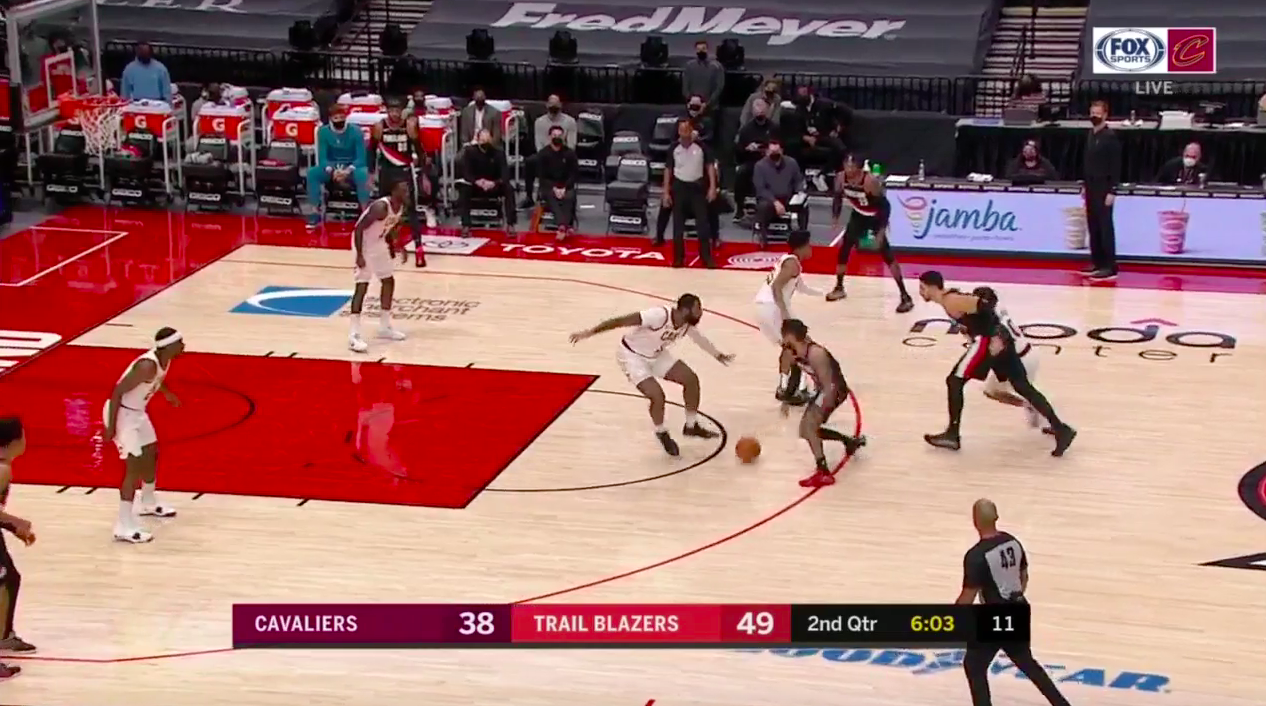
Watch and notice Dre’s stance in each of these clips. He’s so bent over and off-balance his head is well past his own feet.
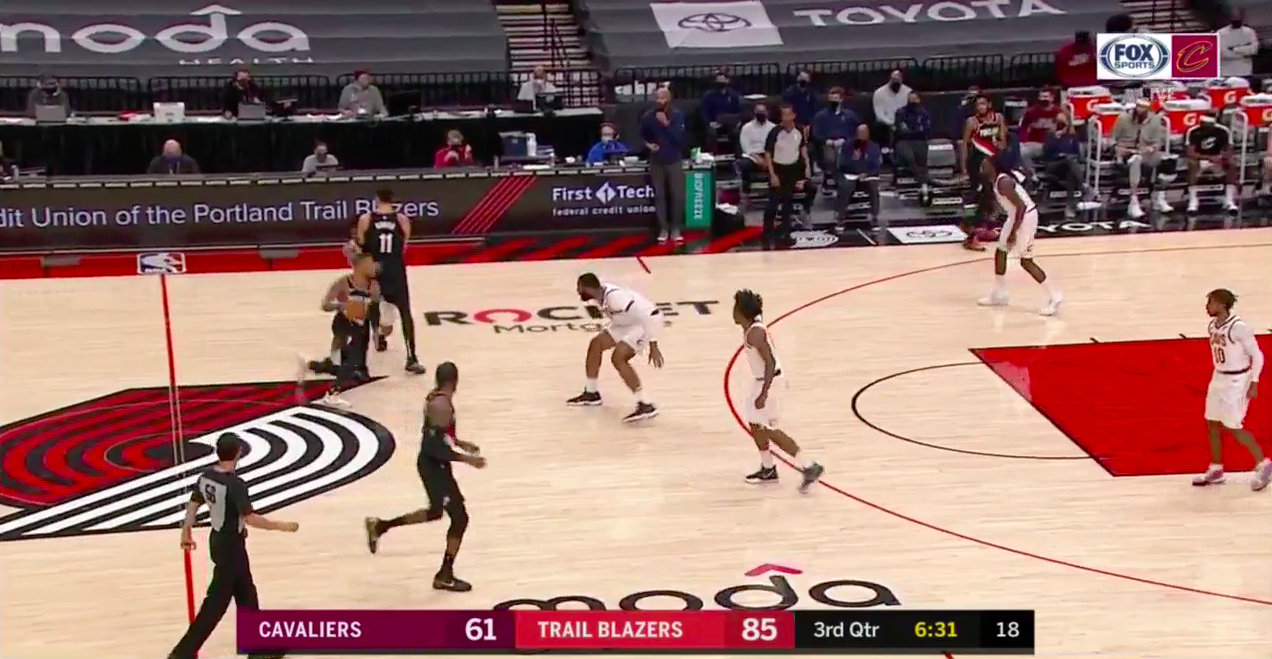
It makes him play lower than his own height, which often leads to his hands down and a lot of “hand down man down” situations. In this clip, he’s literally compressing his own height like an accordion as Dame is rising to shoot.
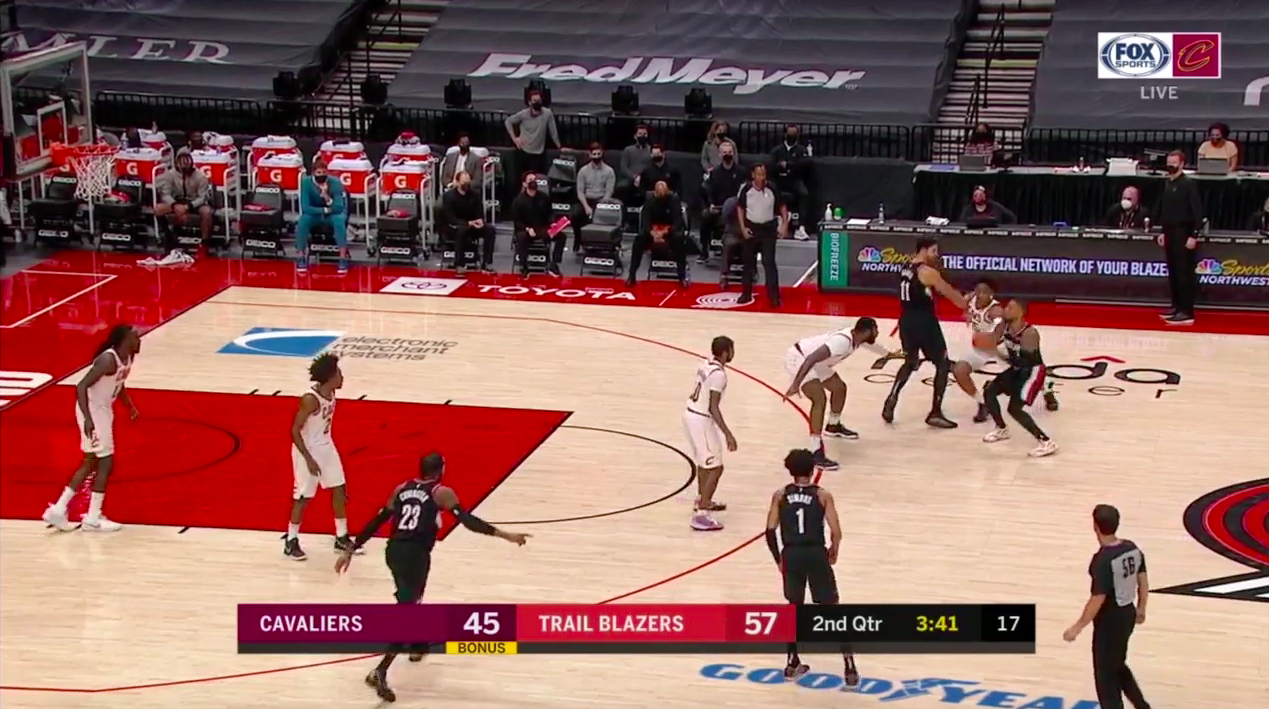
This makes it hard for him to flip his hips and stay “in phase,” as we’d say with a football cornerback. One big difference between some youth basketball coaches and the reality of the NBA is refusing to flip hips and trying to slide to stay in front at all times. If you get beat, you need to flip your hips to recover. Dre staying low and not turning lets him get driven past at times.
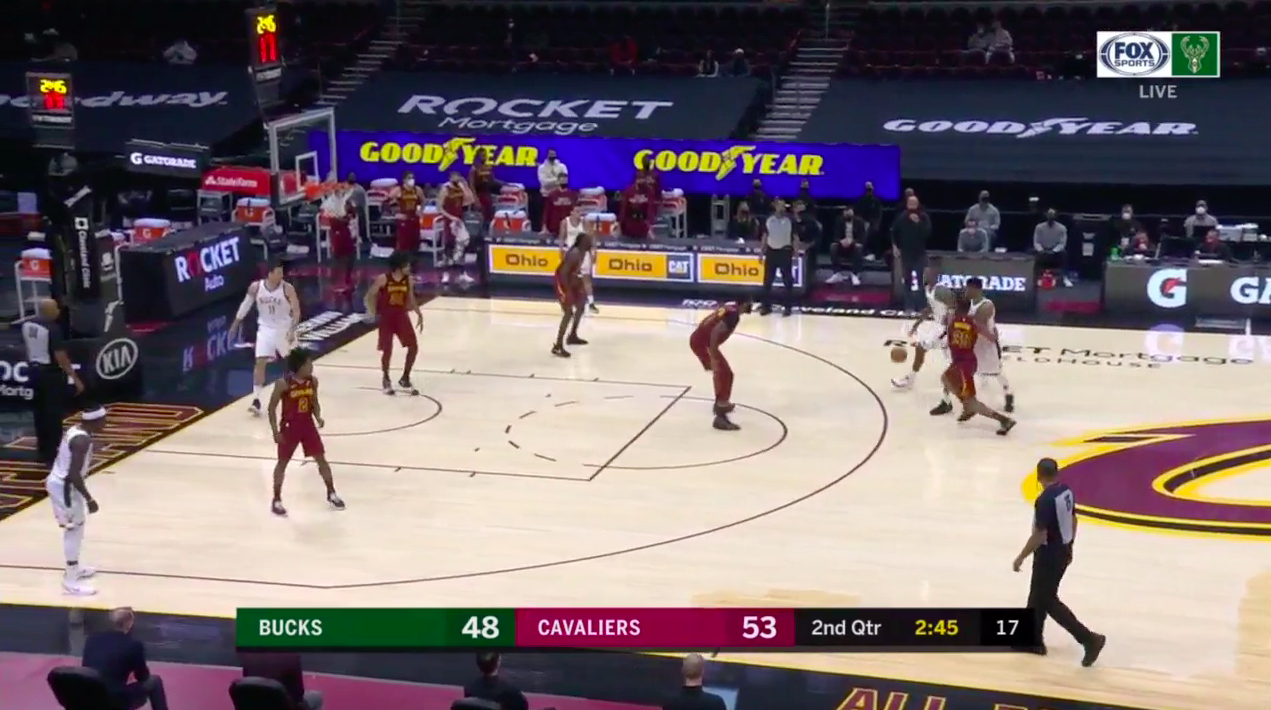
To compensate, we often see Drummond give himself a buffer from being blown by. He’ll also bail out at times in the Cavs drop scheme as a drop variant that just starts with him closer to the screen. Regardless, this head over toes lean for a player conceding ground also makes it difficult to stop and contest against a pull-up, which is what you hope to do with any more aggressive screen coverages.
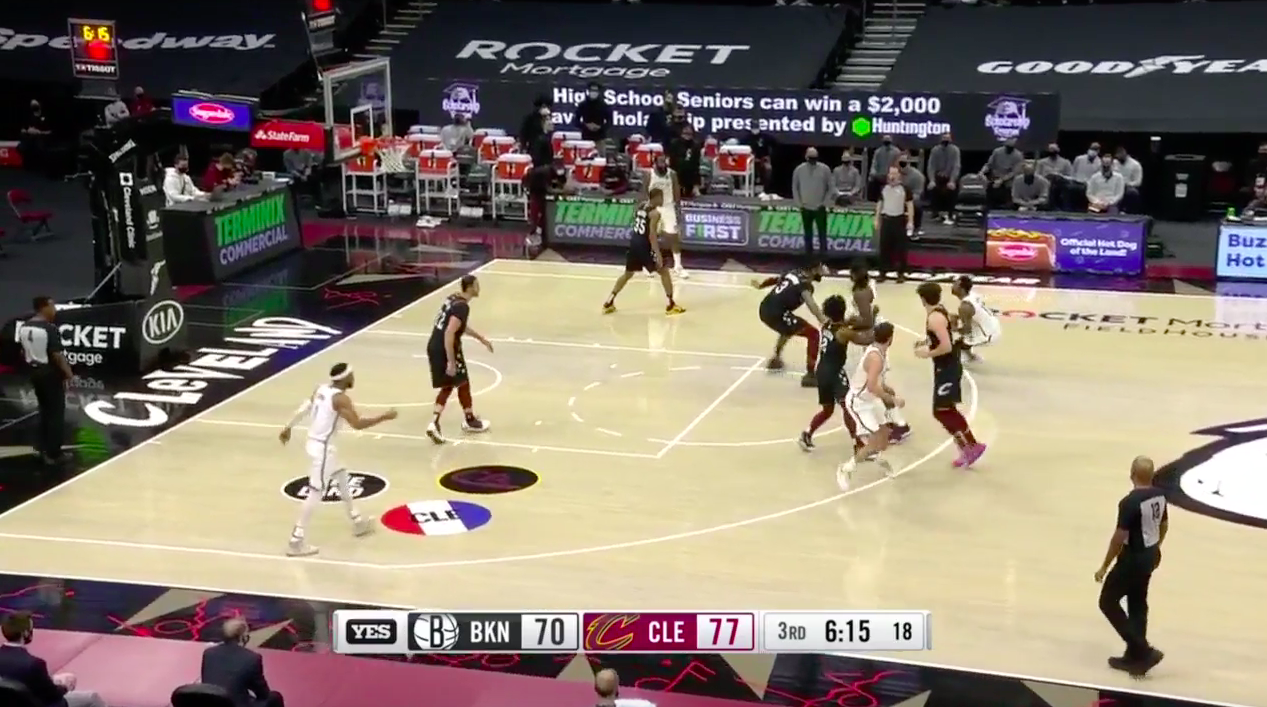
Contrast that with AD, who plays higher but in a balanced stance, fluidly flips his hips to recover to a drive and recover to a step back, and whose balance allows for contesting of pull-up shots in ball screens. Physically they aren’t the same player. From a technique standpoint, they’re not close.
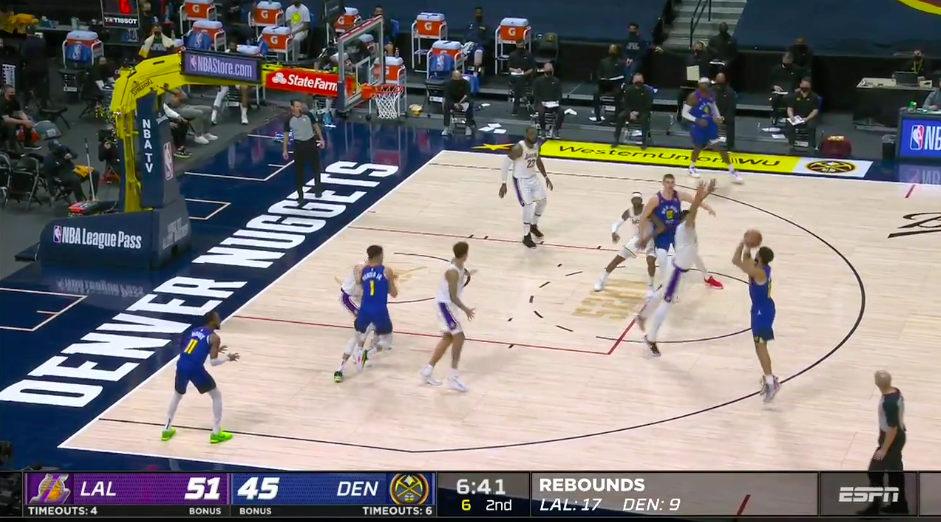
Where Dre’s low to the ground approach does play to his favor is with his quick hands an on-ball steals and deflections as a P&R defender. Get too close to Drummond and he’ll swipe at the ball, often generating turnovers, deflections that end up creating time for the guard in the action to recover or throw the shooter off balance.
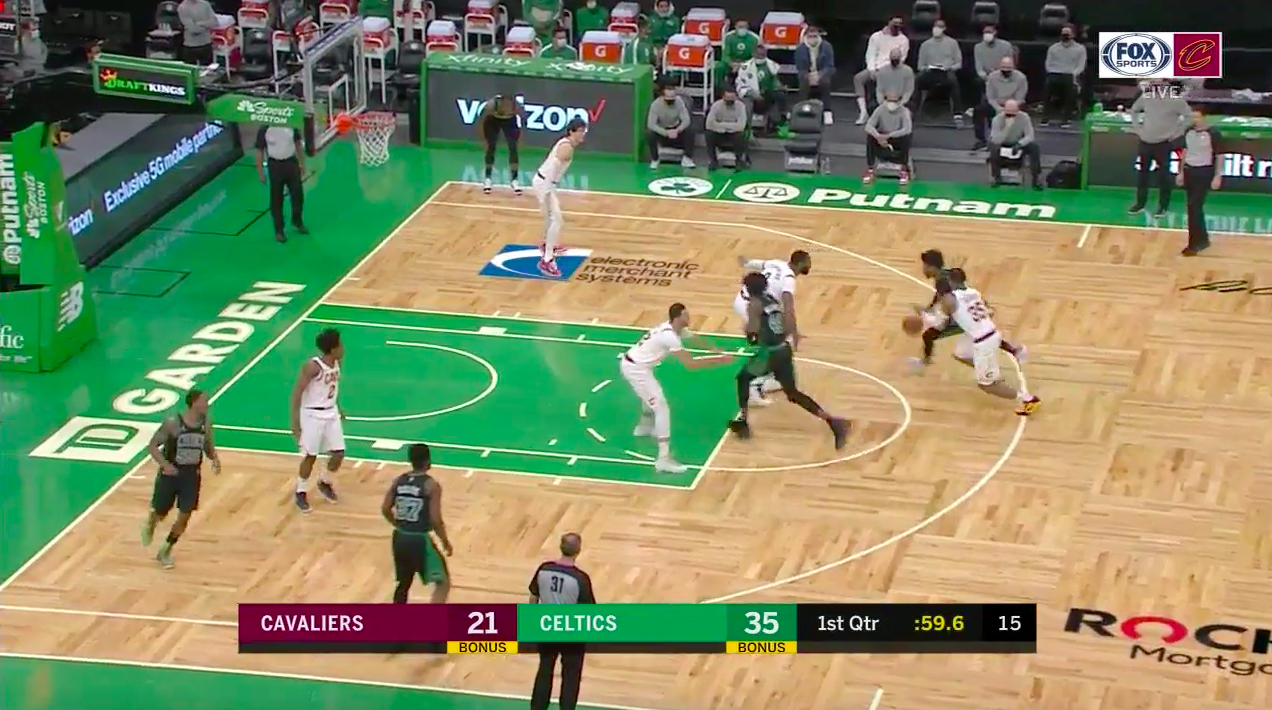
Once opponents do arrive close to the rim on a drive vs Drummond, this is often his move of choice. This does result in non-contests on drives at times, which is more of a point guard way of defending the rim than an anchor big and is frustrating to watch.
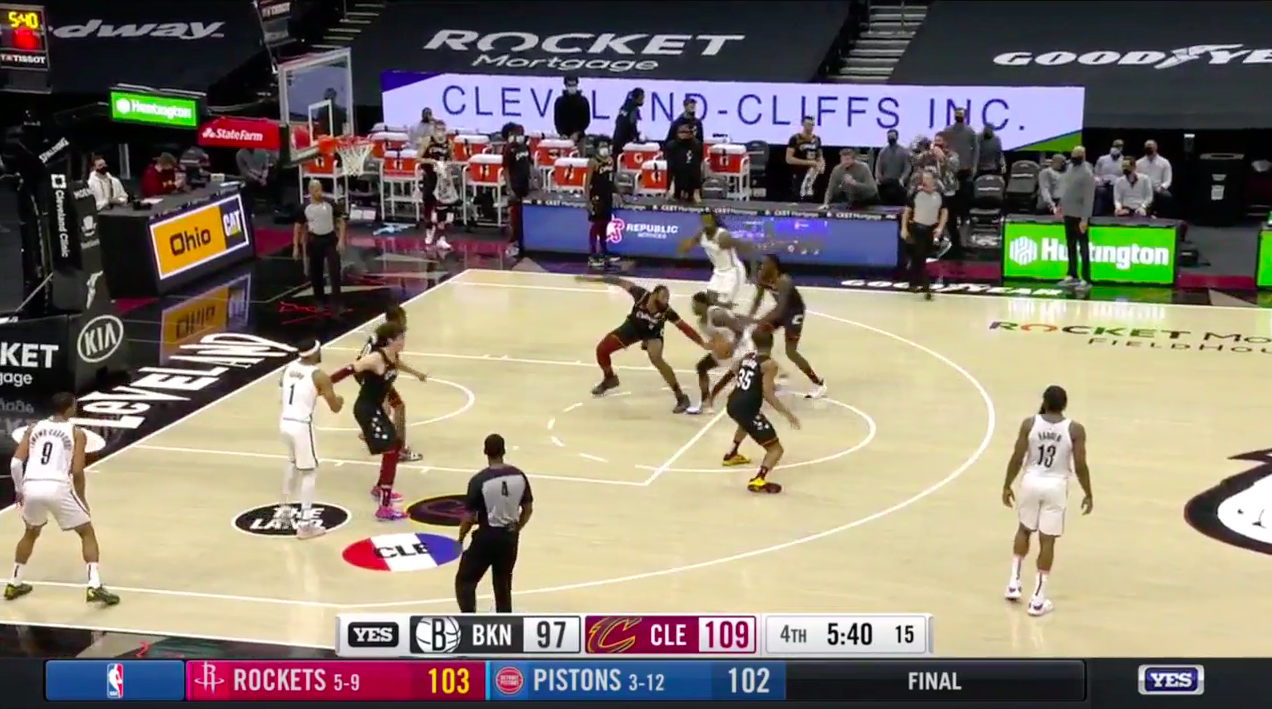
The lack of contesting also extends in a way similar to Trezz and Gasol, and unlike Dwight and JaVale, where there’s far less recovery blocks from any out of position or unideal situations.
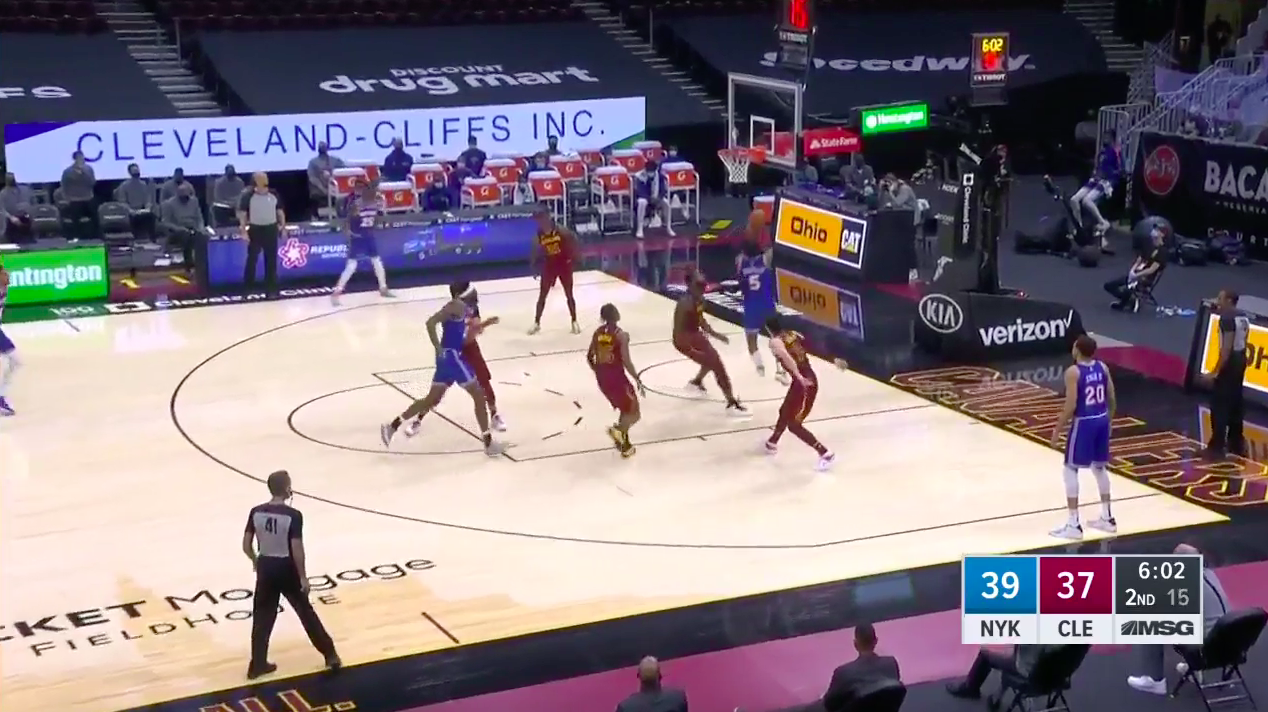
So, does putting Drummond in more situations at the point of attack against an attacking ball handler by deploying him as a catch hedging big a good strategy? My current belief is no. If the Lakers don’t try it over the coming weeks, we have our answer confirmed. If they do try it, and he fails, we arrive at the same conclusion. But if Dre can catch hedge well he raises his playoff stock considerably.
If not, we may see LA primarily drop with Drummond. That’s okay for the regular season. It does introduce a tad more personnel-dependent complexity, but at this point in the season we’ve already seen LA’s base scheme be built out in a more robust way such that this should be fine. It’ll be stronger vs specific types of players and weaker vs others. Then in the playoffs you’d just have to look at Drummond as someone potentially sitting as JaVale and Dwight did last season.
Likewise, I’m not a huge fan of his switching ability There’s a reason why we see other bigs on former teams of his switching more frequently than he was asked to. If he can get that skill set into shape it changes the way we look at his defense.
Defensive Communication
Another role of a center that is less apparent watching on TV but brutally clear in-person is taking a lead for communication. This is another area of concern I have with his defense, but one he’ll have every opportunity to improve and succeed at within a strong Lakers defensive culture.
And with LeBron and AD both currently out, and with Drummond’s lack of shooting making him not a viable partner with Gasol or Trezz, LA might be in a tricky situation if he doesn’t communicate. He won’t have LeBron as a free safety, roaming to clean up messes and actively talking off-ball. Dre will have to call out coverages and keep guys on the same page.
I mention this because of the far too frequent clips I see of his P&R defense that shows misalignment with what his teammates are expecting him to do. Particularly heading into a team with no other heavy drop bigs this season, he needs to talk or there may be miscommunications.
The first clip is more off-ball defense. The second clip shows some… confusion.
— Cranjis McBasketball (@Tim_NBA) March 25, 2021
Playoff Impact
Improving Dre’s playoff stock is important. Even more so given that he’s in the same big man rotation as Montrezl Harrell.
No Big has seen a larger drop in impact from the regular season to the playoffs, using a multi-year look at our LEBRON impact metric, than Montrezl Harrell. Dre is 2nd lowest of all bigs.
In general, Post Scorers on offense and Anchor Bigs on defense are also each the two big man roles that see the largest drops. Those are the roles that both Trezz and Drummond are in.
Based on general roles, the history of the specific players, and the weaknesses of their game, it’s right to have concerns about both players. By adding Dre instead of a type of big potentially more suited for playoff play, LA has locked into their current stable of bigs.
Rotation
So then how will this move impact minutes for the other bigs involved?
Trezz (25 MPG), Gasol (20 MPG), Kieff (18 MPG), AD (33 MGP), and LeBron (34 MPG) will all be impacted. Adding in Drummond
Per the tracking data we use at BBall Index, 40% of LeBron’s time on defense has been spent guarding 4s and 5s. My guess is that drops and he spends far more time defending at the 3, which then likely drops Kuz’s minutes, who has defended a lot at the 3. For AD, it’s been 20% guarding 5s. That’ll rise in the playoffs.
Up to this point in the year, Trezz and Gasol have played a whopping 0 seconds together on the season. Either that’s about to change, or one of the two of those players is about to see a massive drop in minutes.
So what happens? Is Trezz out? I doubt it, given his importance to the team’s offense with AD and LeBron out.
Will the Lakers take on a baseball-style platoon, with a rotating wheel of DNP-CDs based on the night or matchup? Possibly. If we think about which bigs are best where, that can add context for that type of approach:
- Post Defense: Gasol, then AD, then Drummond
- Switching: Kieff/AD
- Catch Hedging: Gasol, Trezz, and AD
- Drop Coverage: Drummond, Gasol, and AD
We have to consider offensive fits as well, mostly from a spacing standpoint. Trezz + Drummond is the one combo that won’t work, so there’s still a bit of flexibility.
Gasol + Trezz works. Drummond + AD works. Drummond + Kieff works. Gasol + AD works. Gasol + Kieff works.
Here’s a guess for minutes for LA’s PF and C minutes before AD is healthy:
PF: Trezz (25 MPG) | Kieff (18 MPG) | LeBron (5 MPG at PF)
C: Drummond (28 MPG) | Gasol (20 MPG)
Here’s a guess for minutes for LA’s PF and C minutes once AD is healthy:
PF: AD (18 MPG) | Trezz (20 MPG) | Kieff (10 MPG)
C: Drummond (18 MPG) | Gasol (15 MPG) | AD (15 MPG)
If you want more AD at the C, you need less Dre/Gasol. If you want more Dre/Gasol and less AD at the C, you need less Kieff/Trezz to fit more AD at PF minutes.
Here’s a guess for minutes for LA’s PF and C minutes in the playoffs, if Drummond were to drop out based on mobility concerns:
PF: AD (10 MPG) | Trezz (13 MPG) | Kieff (25 MPG)
C: Gasol (15 MPG) | AD (25 MPG) | Trezz (8 MPG)
In a scenario like that, Kieff becomes a main beneficiary.
We’ll have to wait and see what this actually looks like, but as long as Trezz plays some PF I see LA able to get minutes to their frontcourt without too much of an issue before AD is back. Once he’s back, Drummond’s time will need to drop quite a bit or it looks like you need to cut Gasol out of the rotation.
Overall
All in all, Drummond will help the Lakers up their offensive rebounding hopefully a lot, their playmaking a good bit (particularly with LeBron out), their defensive rebounding, the rim protection, and with turnover generation and outlet passes leading to more transition offense.
His role, short and long-term, are a question. I think there are a few answers and the best answer is a nuanced one that tries to make the most of his best skills and puts him in fewer situations for failure.
His functional defensive mobility defending ball handlers in space, either in screen coverages or on-ball, are questions I’m hoping to be impressed with but currently have lower hopes for. And the answers to some of those key questions will dictate the confidence in which he can be utilized in the playoffs.

